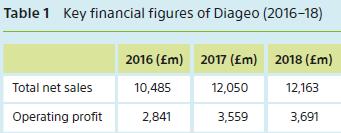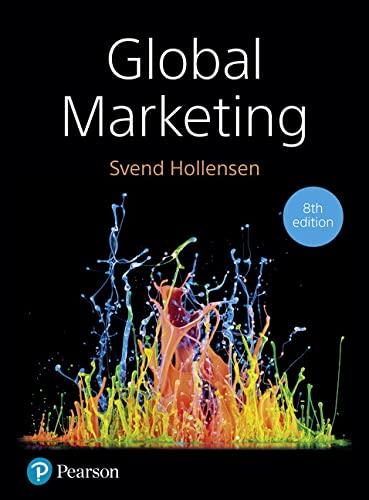Beer is an alcoholic beverage made by brewing and fermenting cereals, especially malted barley, usually with the
Question:
Beer is an alcoholic beverage made by brewing and fermenting cereals, especially malted barley, usually with the addition of hops as a flavouring agent and stabilizer. One of the oldest of alcoholic beverages (there is archaeological evidence dating to
c. 3000 BC), beer was well known in ancient Egypt, where it may have been made from bread. At first brewed chiefly in households and monasteries, it became a commercial product in late medieval times and is now made by large-scale manufacturers in almost every industrialized country. Although British, European and American beers can differ markedly in flavour and content, the brewing processes are similar. A mash prepared from crushed malt (usually barley), water and, often, cereal adjuncts such as rice and corn is heated and rotated in the mash tun to dissolve the solids and permit the malt enzymes to convert the starch into sugar. The solution, called wort, is drained into a copper vessel, where it is boiled with the hops (which provide beer with its bitter flavour), then run off for cooling and settling. After cooling, it is transferred to fermenting vessels where yeast is added, converting the sugar into alcohol. Modern beers contain about 3–6 per cent alcohol. After brewing, the beer is usually a finished product. At this point the beer is kegged, casked, bottled or canned. Beers fall into two broad categories:
• Lighter beer (lagers). Lagers use yeast that ferments more slowly at cooler temperatures and tends to settle, and they are aged at cold temperatures for weeks or months, hence the name (German, lager = storage place). Lagers are the most commonly consumed beer in the world, with brands like Budweiser, Heineken, Fosters, Carlsberg, Beck’s, Carling, Kronenbourg and Stella Artois.
• Darker beer. Included in this broad category are ales, stouts and porters. Stouts (and porters) are dark beers made using roasted malts or roast barley.
Porter is a strong and dark beer brewed with the addition of roasted malt to give flavour and colour. Stout (today more or less identical to Guinness)
is normally darker and maltier than porter and has a more pronounced hop aroma. Porter was first recorded as being made and sold in London in the 1730s. It became very popular in the British Isles, and was responsible for the trend towards large regional breweries with tied pubs. Originally, the adjective ‘stout’ meant ‘proud’ or ‘brave’, but later, after the fourteenth century, ‘stout’ came to mean ‘strong’. The first known use of the word stout about beer was in 1677, the sense being that a stout beer was a strong beer. The expression stout-porter was applied during the 1700s for strong versions of porter, and was used by Guinness of Ireland in 1820, although Guinness had been brewing porters since 1759. ‘Stout’ still meant only ‘strong’ and it could be related to any kind of beer, as long as it was strong: in the UK, it was possible to find ‘stout pale ale’, for example. Later ‘stout’ was eventually associated only with porter, becoming a synonym for dark beer. At the end of the nineteenth century, stout porter beer (especially the so-called ‘milk stout’ – a sweeter version) got the reputation of being a healthy strengthening drink, so it was used by athletes and nursing women, while doctors often recommended it to help recovery. Stouts can be classed into two main categories, sweet and bitter, and there are several kinds of each. Irish stout or dry stout is the original product, equivalent to the Guinness beer. It is very dark in colour and it often has a ‘toast’ or coffee-like taste. Major brands in this broad category include Murphy’s (Heineken), Castle Milk Stout (SAB Miller) and, of course, Guinness (Diageo).
Diageo
UK-based Diageo was formed in 1997 through the merger of Guinness and Grand Metropolitan. Both companies were themselves products of earlier mergers and acquisitions – Guinness had acquired Distillers in 1986 while Grand Metropolitan had diversified from its origins as a hotel chain into spirits (IDV), food (Pillsbury), restaurants (Burger King) and pubs. Diageo sold off Pillsbury and Burger King and the Guinness business was integrated into the global spirits organization.

Today, Diageo is a Fortune 500 company listed on both the New York and London stock exchanges. The firm is the world’s leading premium drinks enterprise, with a broad selection of brands. It currently occupies a 30 per cent share of the global market, and owns nine of the world’s top 20 spirit brands, including Smirnoff vodka, Bushmills Irish whiskey, Johnnie Walker Scotch whisky, Captain Morgan rum, Gordon’s dry gin, J&B Scotch whisky, Crown Royal whiskey and Baileys cream liqueur. The portfolio also includes Guinness stout. In 2019 the company had over 20,000 employees, and traded in over 180 markets around the world.
Its annual turnover in the fiscal year 2018 reached more than £12 billion, of which Guinness accounts for around 12%. Diageo has a total market capitalization of over £25 billion. The financial development of Diageo during 2016–18 is illustrated in Table 1.....
Questions
As an international marketing consultant, you are asked to give an independent assessment of Guinness’s opportunities in the world beer market. You are specifically asked the following questions:
1. How would you explain the Guinness pricing strategy and the underlying assumptions about consumer behaviour when Diageo reports for 2013 to 2018 that in the UK and Ireland Guinness sales volume fell by 5 per cent, but a value growth of 3 per cent was achieved in both markets, mainly due to price increases?
2. Motivated by the success of this pricing strategy, should Diageo continue to increase the price of Guinness?
3. In Choueke (2006), an anonymous beer retail buyer comments on Guinness’s decreasing sales volume:
Guinness has an older profile of drinker and with an ever-increasing availability of continental lagers and a fast-growing range of alcopops, the younger generation of drinkers simply haven’t bought into it. Innovation – widgets and gadgets – will keep the brand alive for a while but where else can Diageo go? Flavoured Guinness? No thanks. It is in decline and Diageo’s best minds can’t do much about it. The brand may have only a couple of decades’ worth of life in it and I would milk it for everything before getting rid of it and concentrating on spirits.
Do you agree with this statement? Explain your reasons.
4. What elements of the Guinness international marketing strategy would you focus on in order to increase both global sales volume, value and profits?
5. What do you think about the ‘1759’ marketing idea?
Should Guinness introduce more special edition beer brands with a limited lifetime for special occasions or as a gift product?
Step by Step Answer:






